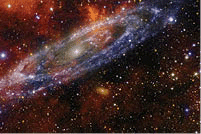Return to 3rd Quarter 2021 articles.

The complexity of the cosmos is so incredible that it baffles the best scientific minds of our day. So scientists have employed elaborate machines to try to understand more of the nature of the creation.
When I was a high school student, we learned that the cosmos is made up of electrons, protons, and neutrons. All of chemistry and physics could be explained by the measurements of these three particles. When I took my first college course in nuclear science, I began to work in the cyclotron, assisting graduate Ph.D. candidates. I realized the creation was not as simple as it appears. As an atheist, this was distressing because I could see that human knowledge of the complexity of the cosmos was, at best, incomplete.
As a graduate student, I was privileged to work with equipment that could smash protons to see what was inside. “Fundamental particles” was a term that began to show up in the scientific literature, and gradually another “simple explanation of everything” began to emerge. It was called “The Standard Model of particle physics.” It consisted of leptons (such as the electron), and quarks which made up protons and neutrons.
This model also required force particles called bosons to hold things together. With larger and more powerful accelerators, scientists discovered still more particles which were the glue holding everything together. These particles were part of the structure of matter called gluons and the Higgs boson. The complexity of the cosmos was becoming more impressive.

Despite all of this work by literally thousands of physicists worldwide, they still saw things that did not fit all of the models. For example, galaxies were spinning too fast to hold together unless some unknown and unseen force was counteracting the centrifugal force of the rotation. The latest measurements show that 68.3% of the creation is made up of energy we cannot detect by any existing instrumentation. We can measure the mass of the cosmos, but 26.8% of the mass we know must be there because of gravitational fields is missing. Scientists now refer to the two missing quantities as “dark energy” and “dark matter.”

To make their theories work, scientists now say that there must be a bizarre form of matter that does not affect or interact with light, visible or invisible, in any way. They call this hypothetical particle that scientists cannot see or detect, “the axion.” The axion would explain dark matter, but the big question is how can we detect it?

As science attempts to understand the nature of the world we live in, it becomes evident that the creation is not just the physical world that our senses can detect. Seeing, smelling, hearing, feeling, and tasting are wonderful, but they are just physical manifestations of something far more significant. The complexity of the cosmos causes us to wonder at the intelligence that created all of this.
For Christians, this is not the mystery that it might be to an atheist. Hebrews 11:3 says it well: “Through faith we understand that the worlds were framed by the Word of God so that things which are seen were not made of things which are visible.” My physics studies have convinced me that the world we can see is just a snippet of the total creation.

We are beginning to understand that there are many dimensions beyond what our senses perceive. Even when we extend our senses with machines, we still cannot detect the axion. The wonder of creation simply brings us back to the Psalmist's song: “The heavens declare the glory of God; and the sky above proclaims his handiwork” (Psalm 19:1). The cry of wisdom in Proverbs 8:22–23 reminds us of our limitations: “The Lord possessed me in the beginning of his way, before his works of old. I was set up from everlasting, from the beginning, or ever the earth was.”

Remember that “All things were made by him; and without him was not anything made that was made” (John 1:3). Science is a friend of faith, and God has given us a limited view of what he has done. The full scope of creation is beyond our comprehension, but science helps fill in some gaps in our understanding. Perhaps someday science will find the axion.
Picture credits:
© rolffimages. Image from BigStockPhoto.com.
© Outer_space. Image from BigStockPhoto.com.
© unaihuiziphotography. Image from BigStockPhoto.com.
© Outer_space. Images from BigStockPhoto.com
© Outer_space. Image from BigStockPhoto.com.
© denbelitsky. Image from BigStockPhoto.com.
Scripture links/references are from BibleGateway.com. Unhighlighted scriptures can be looked up at their website.
